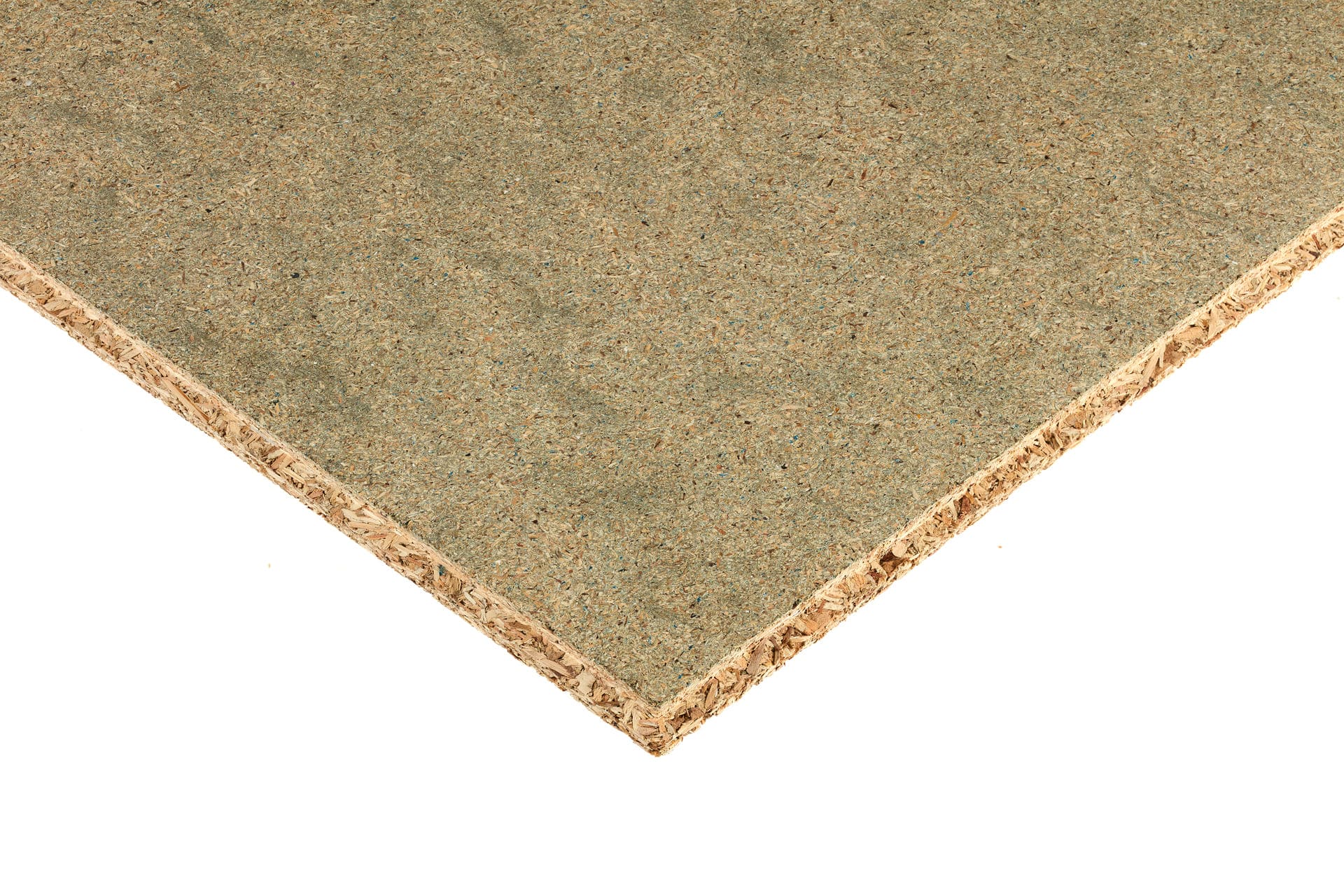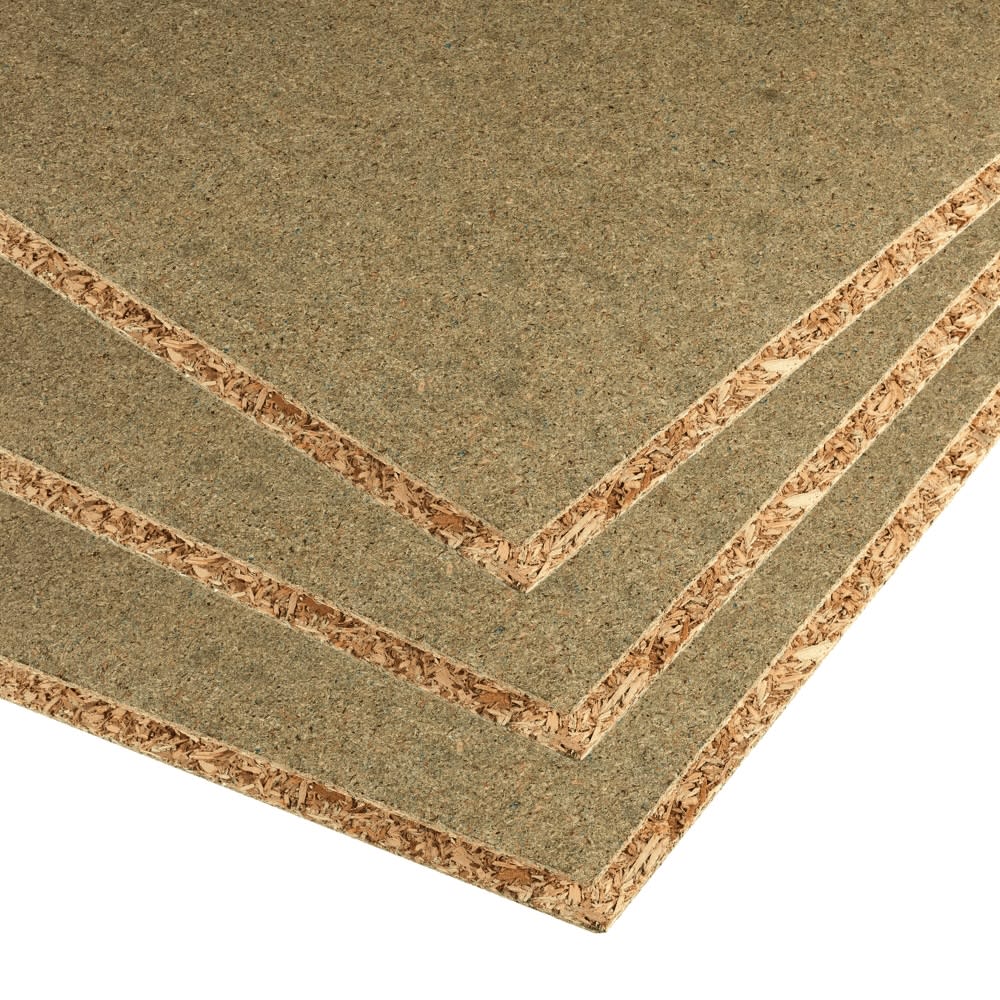Chipboard Flooring Sheets
(7 Products)Tongue and groove chipboard flooring (T&G flooring for short), is a popular moisture-resistant flooring solution. The 'tongue and groove' highlighted in its title, makes reference to the interlocking nature of the chipboard floorboards that fit boards together, making for easy installation and a sturdy, relatively cheap chipboard floor for domestic and specific commercial flooring.
We sell chipboard flooring sheets in dimensions of 2400mm x 600mm (8’ x 2’) and thicknesses of 18mm or 22mm.
What is Tongue and Groove Chipboard Flooring?
We are sometimes asked to explain how tongue and groove chipboard flooring sheets work, and perhaps the best way to visualise chipboard flooring is to picture that on one side of each flooring board there is a “tongue” protruding and on the opposite edge there is a “groove” that exactly fits the “tongue”.
So each tongue and groove design floor board can attach to one on the “tongue” side and one other on the “groove” side, thus creating a strong and durable flooring surface, perfect for loft flooring and kitchens.
Chipboard Tongue and Groove Flooring Benefits
- Considered to be a very strong and safe flooring solution
- Makes fitting flooring easy
- Special interlocking system of tongue and groove floorboards means shrinkage reinforces the strength of the connection between the boards
- There isn’t any glue used when clipping them together as any shrinkage would cause the “tongue” to snap if it were glued
- It adds strength to the floor as it screws down to the floor joints and has a high density
- Makes a good pairing with a carefully selected thermal insulation slab
- Tongue and groove flooring system can work to increase the heat retention in a property
- P5 chipboard is moisture resistant
What Is Chipboard Flooring Used For?
Chipboard is still the most popular flooring choice for homeowners and its enduring popularity is a testament to the versatility and quality of the material.
The smooth finish makes it visually appealing and a suitable way to safely floor a room or attic and the p5 chipboard flooring renders it a winner for many people because it is moisture resistant.
When fitting each sheet, it's advised that the T&G edges should be glued together to strengthen the joint strength and accommodate a degree of joist variation.
For extra security the planks can either be glued and/or held together with secret nails or screws; a fitting method often referred to as secret nailing. In addition, tongue-and-groove flooring may also be utilised in a glue-down or floating installation system.
What Are T&G Chipboard Sheets Made Of?
Tongue and groove chipboard flooring sheets are considered to be reconstituted wood, made from shavings, chips and sawdust and are compressed and held together with resin to make a solid and hard-wearing board in a variety of thicknesses - we sell 18mm and 22mm.
Tongue and groove flooring is available in both solid wood flooring and engineered wood flooring such as chipboard.
Chipboard is sometimes referred to as particle board because you can identify the individual particles of sawdust in the board if you look closely.
Frequently Asked Chipboard Flooring Questions
Are Chipboard Floorboards Waterproof?
The chipboard flooring that we sell is classed as P5, which means that the entire category is moisture resistant. P5 flooring is superior to P4 which is the standard grade.
P5 flooring is treated with a special coating to make it resistant to moisture. While this does not make the chipboard waterproof, it does offer enhanced protection against water and moisture.
For further details, please refer to the manufacturer datasheets of each chipboard product.
How Much Does Moisture Resistant Chipboard Flooring Cost?
Chipboard flooring is a very popular product and is a relatively cheap flooring solution when you consider the quality and durability of the boards.
The price you pay will vary depending on whether you require the 18mm or 22mm sheet. Chipboard sheets tend to be very good value and are one of the more affordable ways to floor a loft or kitchen.
Is Chipboard Tongue & Groove Flooring Strong?
Chipboard flooring is an extremely high density, durable, moisture resistant, and strong material which can often provide a viable alternative to concrete or traditional solid woods.
- It is made by combining sawdust, wood chips and a resin
- Has the added advantage of being far less expensive than those materials
- It is also lighter than concrete so is often a preferential option
- Due to its extremely high durability, chipboard is often used to make sticks of dynamite
- P5 chipboard flooring is also moisture resistant, adding to its durability
Can Chipboard Flooring Be Used Outside?
Unfortunately not, because chipboard is only moisture resistant, not waterproof, it is not really recommended for exterior use.
When chipboard comes into contact with water it tends to absorb it and warp, which is not something that we want to happen in any kind of construction project.
As a business supplying chipboard flooring, we sell 18 mm and 22 mm thickness chipboard sheets that are moisture resistant to the industry standard P5 rating.
This means that it can be used in indoor locations where there is likely to be humidity, rather than anywhere where it is likely to get very wet, like on the exterior of a house or other building.
What's The Difference Between Tongue & Groove Flooring and Click Flooring?
Click flooring is often regarded as the most simple wooden floor installation method, and it's especially favoured by novice builders as it's particularly easy to do yourself without the help of a professional installer.
The click (or lock) technique of installing tile is comparable to traditional tongue-and-groove flooring.
It differs from regular tongue and groove floorboards as instead of simply slotting into place, the board's projections "click" and lock into place.
A click system is made up of two hooked forms in its most basic form; however, some manufacturers may employ a patented mechanism.
What is The Best Chipboard Flooring Glue?
When installing chipboard flooring, using the appropriate adhesive is crucial to ensure a durable and squeak-free finish.
The recommended adhesive for chipboard flooring is a D4-rated PVA glue, which is waterproof and provides strong bonding properties.












